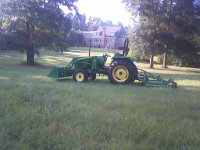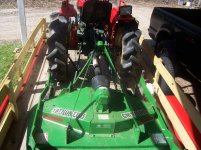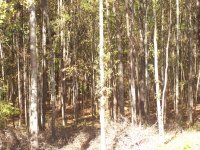The advice from Ernie, Winston, and California is all superb. As usual, just listen to them.

For cutting and moving dirt, there is no tractor too large or heavy. Dozers exist because nothing equals them for demolishing the rock, roots, and soil between the natural landscape and a road. If you are planning to do a lot of heavy ground engagement, the 2420 is better because it is heavier. You will still hang up on rocks and roots.
If you need maneuverability above all, the 1810 will be advantaged, but not drastically. A 1500 would be more agile. If you are cutting paths for motor vehicles, there is little percentage to buying the more maneuverable tractor, since the road will need to be large anyway. Anything the 2420 cannot drive through would be cumbersome for easy riding with a side by side or golf cart, let alone a pickup, primarily due to the width. Even small tractors with loaders are rather longer than it seems they ought to be.
For footpaths, a few hundred dollars will hire a couple strong high school aged guys for enough time to hack out whatever is required, and be far less hazardous than side-hilling a tractor, ROPS or not, and open up more options than would otherwise be reasonably managed by a tractor, whether for blockage by trees, rocks, or other terrain features. The readily accessible parts of a footpath can be smoothed with the tractor anyway.
There is no such thing as too much power when mowing. More power lets you cut better, faster, and/or wider. You can run a narrower mower with a more powerful tractor, but not a wider one with a lower powered machine. This gives more options when shopping used implements, and opens up options for special sales, discounted display items and so forth when new.
Used rear tires are more prevalent in the sizes for the 2310 and 2420 should unexpected damage to new tires occur, and are a more commonly stocked item generally. The 1810 rears are available and sometimes a bit (say, under $50/tire difference) cheaper when new. To be fair, the tires will likely not need replacing in your lifetime barring catastrophic damage.
Generic service parts (Filters, lubricants, belts, etc) are readily available everywhere, and Hoye sells exact replacement parts for most things likely to break outside of reckless abuse. (Seats, hydraulic pumps, steering boxes and the like) Major chassis castings, complete engine assemblies, internal gears, are often only available as salvage parts, but they ARE out there, to some degree or another. Careful use and good maintenance alleviates any concern on that front, personally.
In sum, I think the perks of going up in size and weight to the 2420 are more likely to be appreciated than the minor advantage you will gain in fitting into slightly tighter spaces with the 1810. If maneuverability is all-important, I would suggest at least considering the option of stepping down a size or two, though it would take some convincing of me to persuade me that building a road a 2420 or 2310 cannot traverse is worth it.
Good luck, let us know what you get!



